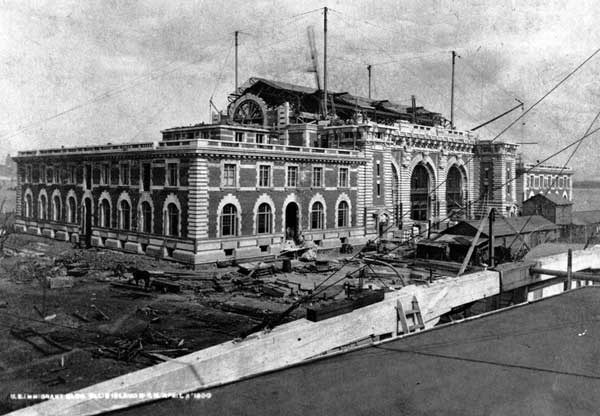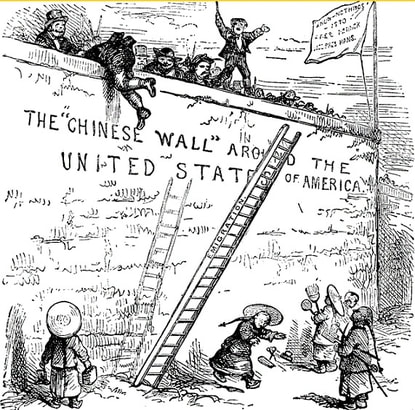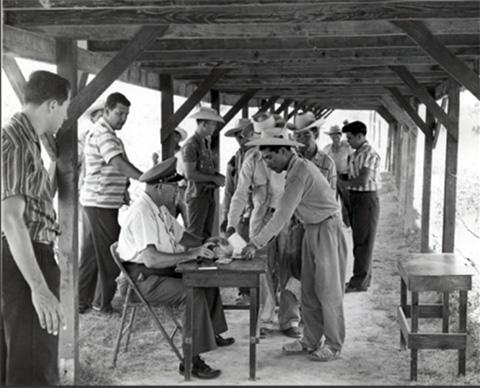Despite Congress’s power to set naturalization criteria, immigration policy, generally, was left to the states. It would take some time for antipathy felt by the native-born toward immigrants to guide federal immigration policy. Early federal laws were primarily concerned with ensuring that immigrants were healthy and able to support themselves. Until the mid-1800s most of the immigrants admitted on the East Coast were Irish or German. Anti-immigrant nativists viewed these immigrants with hostility and formed a political party, the “Know-Nothings” to combat immigrants. Hostility to these new arrivals was assuaged as many of these immigrants participated in the Civil War.
Chinese immigrants began to arrive on the West Coast in the mid-1800s and increased their numbers through the 1860s. By the end of the Civil War, Blacks gained Constitutional protections that were not afforded explicitly afforded to immigrants. Although these protections of Blacks were haphazardly enforced, some immigrants presented an easier target for attack than Blacks. But both immigrants and Blacks faced the same hostility and hatred whether called racism or xenophobia.
Most of these Chinese were males coming to earn money so that they could return to China with enough money to live well. These immigrants worked in mines and helped to build the Union Pacific railroad. Initially, Chinese immigrants were welcomed because they did the hard and dangerous work native workers were reluctant to do. But as the number of Chinese immigrants grew the native antipathy to them also increased. The California legislature taxed immigrant mine workers, and the U.S. Congress passed the Page Act of 1875 to prevent the immigration of Chinese women. In 1882 the U.S. Congress passed the Chinese Exclusion Act. The Act banned all Chinese immigration. Passage of this Act preceded riots and violence against Chinese residents. To meet the labor shortage created by the Chinese Exclusion Act, immigrants from Korea, Japan, and Asian countries were recruited for farm labor. In 1877 the Alien Land Act prohibited Asian immigrants from buying land because they could not become naturalized citizens.
The Immigration Act of 1891 was passed to give the federal government control over the admission and naturalization to these immigrants. As a result of the Spanish American War of 1898, the Philippines became a colony of the U.S., and many Filipinos came to the U.S. as farmworkers. When the Philippines became a commonwealth, Filipino immigration was barred under the Oriental Exclusion Act. By 1913 Asian farmworkers supplied enough farm labor to pose a threat to native farmers.
Although anti-immigrant feeling somewhat dissipated following WWI, anarchist violence and labor strikes stoked a red scare directed primarily Jews and Russians. In part, as a result of this violence and strikes, a quota system was established. It limited new immigration from individual nations to not exceed more than two percent of the immigrants from that nation living in the U.S. in 1890, before a significant migration of Southern and Eastern Europeans. As the number of Jewish refugees increased due to Hitler’s rise in Germany, humanitarians argued for the admission of Jewish refugees exceeding the 2 percent quota imposed by this law. Nativists opposed to the entry of Jewish refugees prevented their entrance.
Although many Mexicans were living in the Southwest territories that Mexico ceded to the U.S. in 1848, many chose to return to Mexico because they “felt like foreigners” in what had once been their land. For example, a “vagrancy” act, taxed Mexican miners who were armed or otherwise not “peaceable and quiet persons.” Over time, Mexican immigration increased. By the early 1900s, a civil war, policies that stripped land ownership, and rampant poverty led many Mexicans to move to the U.S. Between 1900 and 1930 the number of Mexicans in the Southwest increased from just over a quarter of a million to over a million immigrants. The presence of these Mexican immigrants was used, in part, as an explanation for the Great Depression and the unemployment of U.S. citizens.
This Mexican influx led to a number of retaliatory acts against Mexican-Americans and Mexican immigrants. Patients were removed from hospitals and taken to the border. Public employees were arrested and deported. Latino neighborhoods were raided, and the people found there also expelled. Many of these people were American citizens.
During World War II, the loss of native labor once again renewed the demand for Mexican labor. In 1943 temporary Mexican laborers were admitted to the U.S. under the bracero program to fill agricultural jobs. Undocumented Mexican workers also migrated to the U.S. to work, and some braceros overstayed their temporary permits. Farmers were glad to hire these Mexicans because these undocumented workers could not organize or ask for higher pay. After the war, many nativists resented the program because it lowered wages and brought foreigners to the country. These nativists also protested about crimes that these foreign workers supposedly committed.
In 1954 President Dwight Eisenhower, concerned about illegal immigration, implemented Operation Wetback. Operation Wetback was a program to deport undocumented Mexicans. The Border Patrol, U.S. military, and other law enforcement agencies packed any undocumented workers they found into buses and trains and shipped them into the interior of Mexico so they could not quickly return to the U.S. Eighty-eight workers who had been transported to the Mexican dessert died of heat stroke. One aspect of this program was to strike fear into workers to deter them from returning to the U.S.
Despite practices in the program that allowed workers to be abused, the bracero program continued until 1964 because it provided cheap labor to farmers. Undocumented immigrants continued to come to the U.S. for employment and were welcomed by employers as a source of cheap and pliant labor. Thus, the seeds were sown for cheap labor from Latin America. Political upheaval and the anti-Communist fight in Latin America, especially Cuba, also increased the flow of immigrants.



